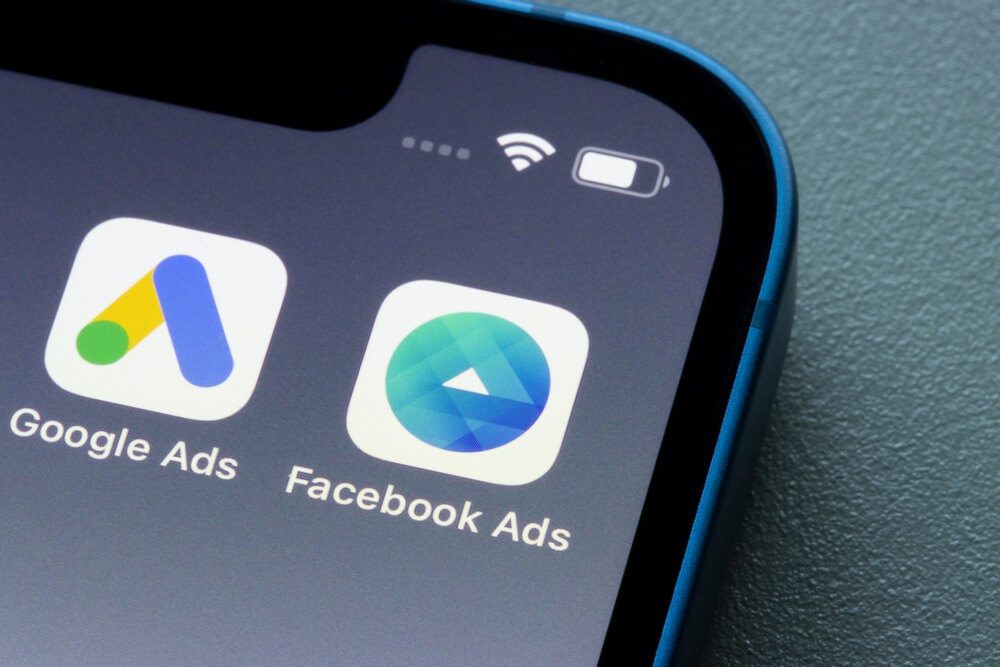
Crafting the Best Retargeted Ads for Healthcare Digital Marketing
Retargeted ads in healthcare digital marketing are for individuals who previously interacted with your website or showed interest in your medical services but did not make an appointment, purchase a product or seek more information. Retargeting is instrumental in developing meaningful connections with prospective and existing patients. When using retargeting, you can remind, educate, and guide previous visitors toward conversion.
Here is a comprehensive guide to steps for crafting compelling retargeted healthcare ads:
 Effective retargeted healthcare ad content requires clear messaging, captivating visuals, and specific information.
Concise messaging highlighting unique services or benefits resonates with audiences, encouraging immediate action. Engaging visuals with concrete details and an empathetic tone foster greater trust. They also address concerns and, when well crafted, demonstrate a deep understanding of patient needs. These elements enhance the effectiveness of retargeted ads in healthcare marketing.
Take these tips to create compelling ad content for healthcare audiences:
Effective retargeted healthcare ad content requires clear messaging, captivating visuals, and specific information.
Concise messaging highlighting unique services or benefits resonates with audiences, encouraging immediate action. Engaging visuals with concrete details and an empathetic tone foster greater trust. They also address concerns and, when well crafted, demonstrate a deep understanding of patient needs. These elements enhance the effectiveness of retargeted ads in healthcare marketing.
Take these tips to create compelling ad content for healthcare audiences:
 Several options exist when considering digital platforms for healthcare retargeting, each with unique advantages for reaching and engaging specific audiences.
Several options exist when considering digital platforms for healthcare retargeting, each with unique advantages for reaching and engaging specific audiences.
 Balancing the frequency and timing of retargeted ads is critical in healthcare marketing to maintain patient interest without overwhelming them. Overexposure leads to ad fatigue, causing users to disengage or perhaps develop negative brand perceptions.
Carefully time ads to coincide with key moments in a patient’s healthcare journey or when they are most likely to be interested. For example, schedule an ad after appointments or publish more frequently during seasonal campaigns. This approach maintains interest and encourages positive interaction.
Consider these techniques to determine optimal ad frequency and scheduling of healthcare retargeting campaigns:
Balancing the frequency and timing of retargeted ads is critical in healthcare marketing to maintain patient interest without overwhelming them. Overexposure leads to ad fatigue, causing users to disengage or perhaps develop negative brand perceptions.
Carefully time ads to coincide with key moments in a patient’s healthcare journey or when they are most likely to be interested. For example, schedule an ad after appointments or publish more frequently during seasonal campaigns. This approach maintains interest and encourages positive interaction.
Consider these techniques to determine optimal ad frequency and scheduling of healthcare retargeting campaigns:
 Adhering to healthcare advertising regulations and upholding ethical standards maintains trust and credibility. Compliance with legislation and accepted protocols ensures ads are truthful and accurate and do not mislead patients regarding medical services or outcomes.
Ethical practices safeguard patient privacy, respect sensitive health information, and promote transparency. All these foster a positive relationship between healthcare providers and their audience based on integrity and responsibility.
Follow these healthcare digital marketing strategies to ensure patient privacy and comply with industry advertising laws:
Adhering to healthcare advertising regulations and upholding ethical standards maintains trust and credibility. Compliance with legislation and accepted protocols ensures ads are truthful and accurate and do not mislead patients regarding medical services or outcomes.
Ethical practices safeguard patient privacy, respect sensitive health information, and promote transparency. All these foster a positive relationship between healthcare providers and their audience based on integrity and responsibility.
Follow these healthcare digital marketing strategies to ensure patient privacy and comply with industry advertising laws:
- Identify the target audience.
- Design effective retargeted ad content.
- Personalize the ads for relevance.
- Choose the right platforms.
- Use data and analytics for targeting.
- Balance the frequency and timing of ads.
- Measure the success of retargeting campaigns.
- Comply with ethical practices and regulations.
Are you looking for help with marketing your healthcare business? Watch the video below to learn our approach to healthcare marketing and why 150+ healthcare companies have chosen Digital Authority Partners to help them generate more leads and patient appointments.
1. Identify the Target Audience
Accurately identifying the target audience is critical when deploying retargeted ads in healthcare marketing campaigns. Understanding the diverse audience segments, whether previous site visitors, past patients, or individuals who engaged with initial ads, enables marketers to effectively tailor their messaging. This precision results in personalized content that is more appealing to prospective leads. It maximizes the effect and conversion potential of retargeted ads, especially in healthcare. Consider these strategies for segmenting healthcare audiences:- Categorize leads based on their actions on the healthcare website, such as pages visited, time spent, or specific services researched. For instance, segment users who explored pediatric services separately from those interested in elder care.
- Divide visitors based on where they are in the conversion funnel. Retarget differently those who viewed appointment pages but did not book and individuals who added services to their cart but did not purchase.
- Identify and segment based on the types of healthcare content they engaged with, such as blog articles, videos, or patient testimonials. Target users based on interest in specific health topics or treatment options.
- Group users based on their engagement with healthcare-related emails. Categorize them according to those who regularly click or open emails, subscribe to newsletters, and those who do not tend to engage.
- Create segments of individuals who have previously booked appointments, received services, or provided feedback. Target them with loyalty programs, post-service follow-ups, or related health check-ups.
- Organize users with incomplete forms, abandoned appointments, or dropped inquiries. Retarget them with personalized messages encouraging them to complete their intended actions.
2. Design Effective Retargeted Ad Content
 Effective retargeted healthcare ad content requires clear messaging, captivating visuals, and specific information.
Concise messaging highlighting unique services or benefits resonates with audiences, encouraging immediate action. Engaging visuals with concrete details and an empathetic tone foster greater trust. They also address concerns and, when well crafted, demonstrate a deep understanding of patient needs. These elements enhance the effectiveness of retargeted ads in healthcare marketing.
Take these tips to create compelling ad content for healthcare audiences:
Effective retargeted healthcare ad content requires clear messaging, captivating visuals, and specific information.
Concise messaging highlighting unique services or benefits resonates with audiences, encouraging immediate action. Engaging visuals with concrete details and an empathetic tone foster greater trust. They also address concerns and, when well crafted, demonstrate a deep understanding of patient needs. These elements enhance the effectiveness of retargeted ads in healthcare marketing.
Take these tips to create compelling ad content for healthcare audiences:
- Emphasize the specific benefits of healthcare services or treatments. Focus on how they improve an individual’s life and address pain points or concerns. For instance, highlight shorter recovery times, improved quality of life, or specialized care.
- Craft ad content using sympathetic and caring words to make patients feel understood and supported.
- Incorporate elements that build trust. These include certifications, accreditations, or endorsements from reputable healthcare professionals. Highlight your expertise and years of experience.
- Create content that explains medical procedures, promotes health awareness, or shares tips for better wellness to position the brand as a reliable source of information to build trust and authority.
- Use visually appealing, relevant graphics or images. Avoid overly clinical visuals and opt for imagery that evokes positive emotions.
- Add clear and compelling calls to action (CTAs) that guide the readers toward the desired action, whether that is scheduling an appointment, downloading a guide, or subscribing to a newsletter.
3. Personalize the Ads for Relevance
Personalization improves the relevance and effectiveness of retargeted ads in healthcare digital marketing. Tailoring them based on past interactions, preferences, and specific healthcare needs fosters a deeper audience connection. Offering personalized solutions, addressing unique concerns, and presenting relevant services also significantly enhances engagement and conversion. They demonstrate that you deeply understand and care for each patient’s journey. Here are effective ways to tailor ads based on user behavior, interests, and previous interactions with healthcare services.- Use dynamic ad content adapted to the user’s previous interactions. Display tailored messages showcasing services or treatments they have previously shown interest in, reflecting their browsing history or past appointments.
- Create behavior-oriented campaigns for specific segments. For example, target users who have shown interest in orthopedic care differently from those interested in mental health services.
- Retarget users with incomplete appointment bookings or form submissions. Display ads to remind them to complete the action while offering incentives or guidance to encourage completion.
- Run recommendation engines to suggest healthcare services or related content based on the audiences’ past interactions with your ads.
- Adjust ad formats based on user behavior and preferences. For instance, serve video-based ads highlighting healthcare services or testimonials for increased engagement for those who enjoy streaming.
4. Choose the Right Platforms
 Several options exist when considering digital platforms for healthcare retargeting, each with unique advantages for reaching and engaging specific audiences.
Several options exist when considering digital platforms for healthcare retargeting, each with unique advantages for reaching and engaging specific audiences.
a. Google Ads (including Display Network and YouTube)
Google Ads has a vast reach across its search engine, display network, and YouTube. It allows healthcare marketers to retarget users who have previously searched for specific healthcare terms or visited related websites. It is effective for reaching those actively seeking healthcare information or services.b. Facebook and Instagram
These platforms offer robust ad-targeting capabilities based on user demographics, interests, and behaviors. Healthcare marketers can retarget users according to their engagement with previous content and employ engaging visuals and storytelling to connect with audiences.c. LinkedIn
Ideal for business-to-business (B2B) healthcare marketing, LinkedIn retargets based on professional demographics and interests. It is suitable for promoting medical services, networking with other providers, and sharing industry-specific content.d. X (Formerly Twitter)
X’s ad platform enables retargeting based on user interests, engagements, and followers. It effectively shares healthcare news and updates and engages in conversations within the healthcare community.e. Native Advertising Platforms
Platforms such as Taboola and Outbrain offer native ad placements on various publisher websites. These tools help reach users with healthcare-related information while they browse news articles or other relevant content online. When selecting the right platform for retargeting, analyze data to learn where specific audiences frequently search, consume, and discuss healthcare content. Additionally, consider the nature of the healthcare services or content on their radars. Some platforms might be more suitable for promoting specific services or engaging with different segments. Aligning the chosen platforms with an audience’s preferences maximizes the effectiveness of retargeting efforts. Carefully directed ads reach and resonate with the right people at the right time and place.5. Use Data and Analytics for Targeting
Leveraging data and analytics is crucial for refining targeting and messaging in retargeted ads. Here are some strategies to determine the success of healthcare marketing efforts:- Use website analytics tools such as Google Analytics to learn user behavior. Analyze which pages users visited, how long they stayed, and the actions taken. Identify high-traffic pages and those frequently abandoned to tailor retargeted ads based on revealed interests and intents.
- Monitor social media interactions to gather insights into audience engagement. Analyze which posts or content generate the most likes, comments, and shares. Use this to shape retargeted ads that resonate with the audience’s preferences and interests.
- Use patient data but adhere to the Health Insurance Portability and Accessibility Act (HIPAA) to discover demographics, medical histories, and service preferences.
- Analyze patterns in patient behavior, such as appointments booked or feedback provided. Create retargeted ads with relevant services or follow-up care based on these insights.
- Conduct A/B tests with different ad variations to identify which messaging, visuals, or CTAs resonate best with the audience.
- Segment audiences based on their interactions and preferences with customer relationship management tools. Group patients according to their healthcare journey, importance, or behavior.
- Implement attribution models to understand the effectiveness of different touchpoints in the patient journey. Identify which channels or interactions contribute most to conversions. Allocate resources and adjust retargeted ad strategies based on these insights to maximize returns.
6. Balance the Frequency and Timing of Ads
 Balancing the frequency and timing of retargeted ads is critical in healthcare marketing to maintain patient interest without overwhelming them. Overexposure leads to ad fatigue, causing users to disengage or perhaps develop negative brand perceptions.
Carefully time ads to coincide with key moments in a patient’s healthcare journey or when they are most likely to be interested. For example, schedule an ad after appointments or publish more frequently during seasonal campaigns. This approach maintains interest and encourages positive interaction.
Consider these techniques to determine optimal ad frequency and scheduling of healthcare retargeting campaigns:
Balancing the frequency and timing of retargeted ads is critical in healthcare marketing to maintain patient interest without overwhelming them. Overexposure leads to ad fatigue, causing users to disengage or perhaps develop negative brand perceptions.
Carefully time ads to coincide with key moments in a patient’s healthcare journey or when they are most likely to be interested. For example, schedule an ad after appointments or publish more frequently during seasonal campaigns. This approach maintains interest and encourages positive interaction.
Consider these techniques to determine optimal ad frequency and scheduling of healthcare retargeting campaigns:
- Conduct A/B tests to evaluate the effect of varying ad frequencies on audience engagement and conversion rates. Test different frequency caps to find the sweet spot when ads remain effective without overwhelming users.
- Map out the patient’s healthcare journey stages and align ad frequency accordingly. Increase frequency during critical decision-making stages or post-appointment follow-ups, ensuring timely and relevant messaging.
- Use dayparting to schedule ads when the audience is most active and likely to engage. Consider time zone differences for a global or diverse audience, optimizing ad delivery for various geographic regions.
- Take advantage of seasonal opportunities, such as the flu season, health awareness months, or special events. Adjust ad frequency and messaging during these periods to capitalize on increased interest.
- Gather feedback from the audience regarding ad frequency. Use the data to fine-tune and optimize scheduling based on their ad preferences and tolerance.
7. Measure the Success of Retargeting Campaigns
Measuring the effectiveness of retargeted ad campaigns determines patient/customer returns and refines future strategies. It also provides valuable insights into which ad variations, targeting methods, or platforms yield the best results, thus assisting data-driven decision-making. Understanding campaign performance optimizes ad spend, improves audience targeting, and enhances messaging. Resources can then go toward tactics that generate the highest impact and conversion rates. Consider these metrics and key performance indicators (KPIs) when evaluating the success of retargeted ad campaigns:- Click-through rate (CTR): measures the percentage of users who click on the ad after seeing it. A higher CTR indicates better ad engagement and relevance to the audience.
- Conversion rate: tracks the percentage of users who complete the desired action, such as booking an appointment, downloading a guide, or signing up for a newsletter. A high conversion rate signifies effective ad targeting and compelling content.
- Return on investment (ROI): determines the campaign’s profitability and compares its running costs to the conversion revenue. A positive ROI indicates that the marketing efforts are financially viable.
- Cost per acquisition: measures the cost of acquiring a new patient or customer. It assesses the campaign’s efficiency in achieving conversions at a reasonable price.
- Ad frequency and reach: monitors the frequency of exposure and the unique reach of the campaign. Balancing frequency and reach helps prevent ad fatigue and ensures ads are sent to a diverse audience without overexposure.
- Engagement metrics: tracks engagement metrics such as time spent on site, pages visited, or video views for a deeper understanding of user behavior post-click. Analyzing these factors helps gauge the quality of traffic from ads.
- Return visits and retention: measures whether and how retargeted users return to the website or engage with subsequent content. Higher return visits indicate sustained interest and the potential for long-term engagement.
8. Comply with Ethical Practices and Regulations
 Adhering to healthcare advertising regulations and upholding ethical standards maintains trust and credibility. Compliance with legislation and accepted protocols ensures ads are truthful and accurate and do not mislead patients regarding medical services or outcomes.
Ethical practices safeguard patient privacy, respect sensitive health information, and promote transparency. All these foster a positive relationship between healthcare providers and their audience based on integrity and responsibility.
Follow these healthcare digital marketing strategies to ensure patient privacy and comply with industry advertising laws:
Adhering to healthcare advertising regulations and upholding ethical standards maintains trust and credibility. Compliance with legislation and accepted protocols ensures ads are truthful and accurate and do not mislead patients regarding medical services or outcomes.
Ethical practices safeguard patient privacy, respect sensitive health information, and promote transparency. All these foster a positive relationship between healthcare providers and their audience based on integrity and responsibility.
Follow these healthcare digital marketing strategies to ensure patient privacy and comply with industry advertising laws:
- Avoid using identifiable patient information in retargeted ads without explicit consent. Focus on aggregate or de-identified data to maintain patient confidentiality.
- Use anonymized and aggregated data to protect patient identities. Avoid displaying personally identifiable information such as names, addresses, or specific medical conditions in retargeted ads.
- Obtain explicit consent from patients before using their testimonials, reviews, or success stories in ads. Ensure patients understand how you will use their information and obtain written permission.
- Communicate data collection practices and privacy policies to patients. Provide easy-to-understand information on collecting, storing, and using data in retargeting efforts.
- Implement policies for limited data retention. Regularly review and securely dispose of outdated or unnecessary data.
- Conduct compliance audits regularly to ensure that retargeted ad campaigns align with healthcare advertising laws and patient privacy regulations. Stay updated with evolving legal standards and adjust practices to maintain compliance.
Summing Up
Effective retargeted ads in healthcare digital marketing involve personalized messaging, sympathetic content, and clear communication of medical benefits. Segmentation based on user behavior, precise targeting, and leveraging data analytics are also important to maintain ad relevance. Retargeting is a critical tool to build connections with patients at different stages of their healthcare journey. Marketers use this tactic to provide tailored solutions, promote trust, and enhance engagement. What are the creative ways you can enhance patient experience through retargeted ads? Find out the answers by consulting a digital marketing specialist. Contact Digital Authority Partners, the top agency for healthcare marketing success.Want To Meet Our Expert Team?
Book a meeting directly here



